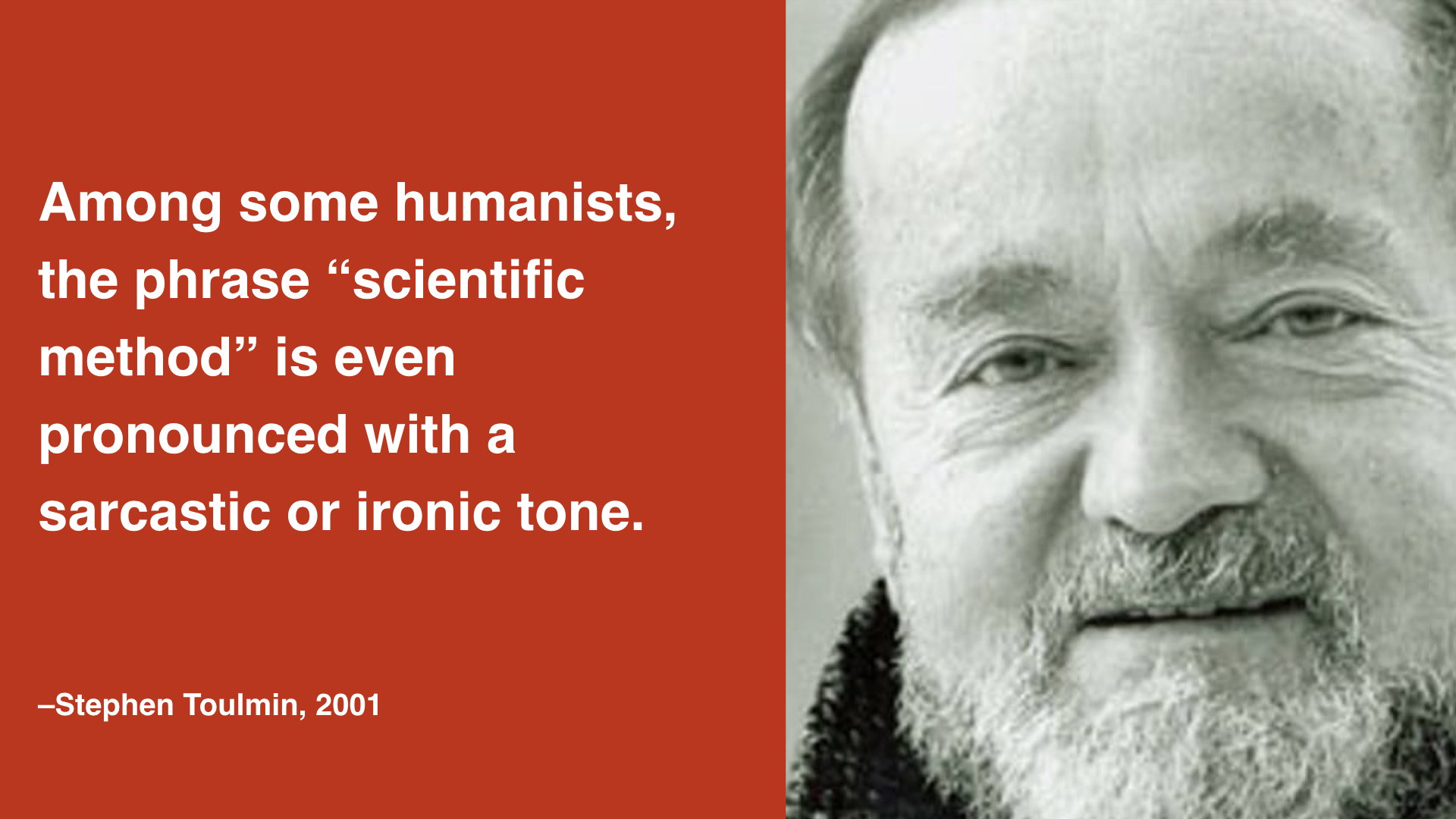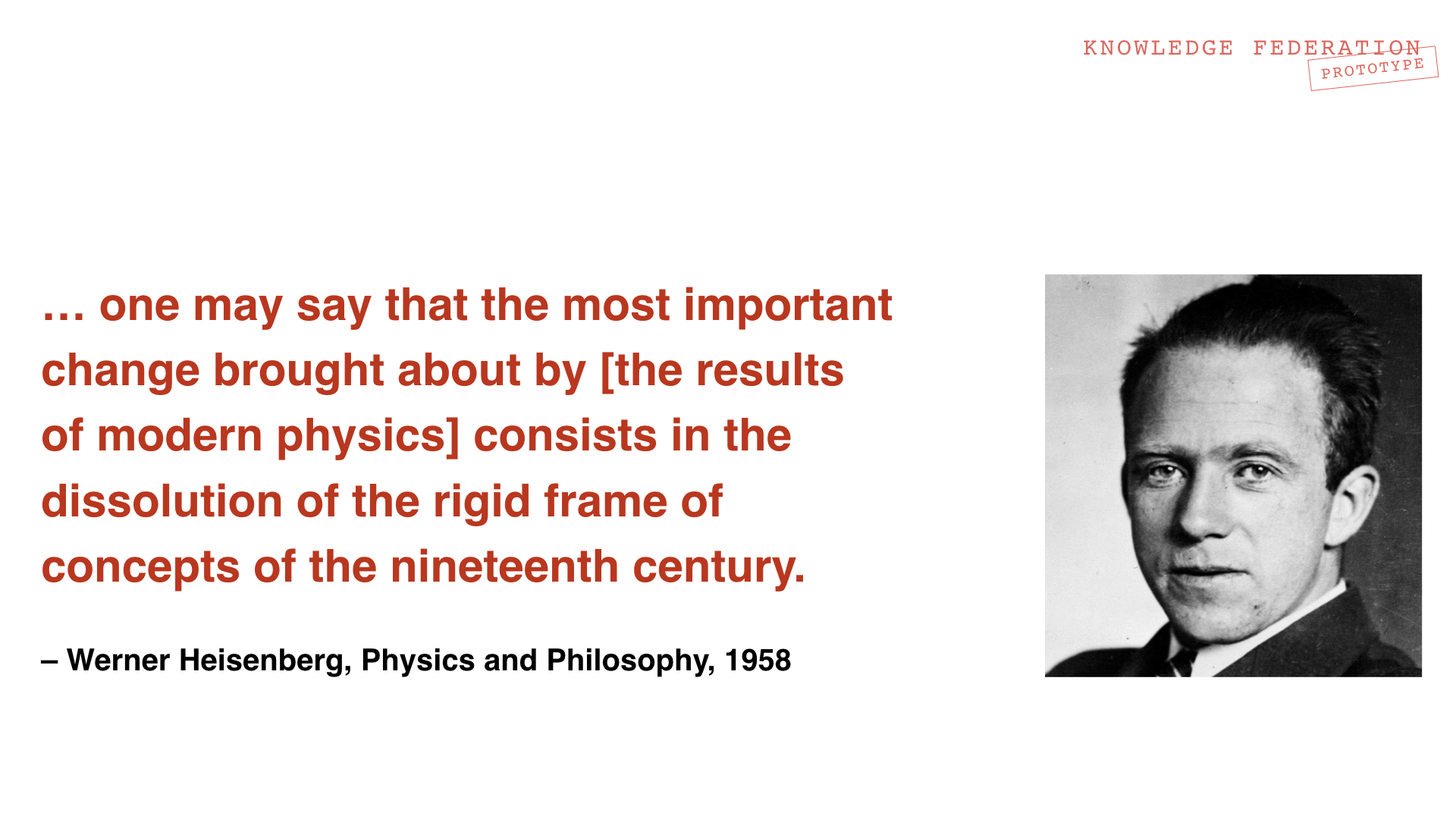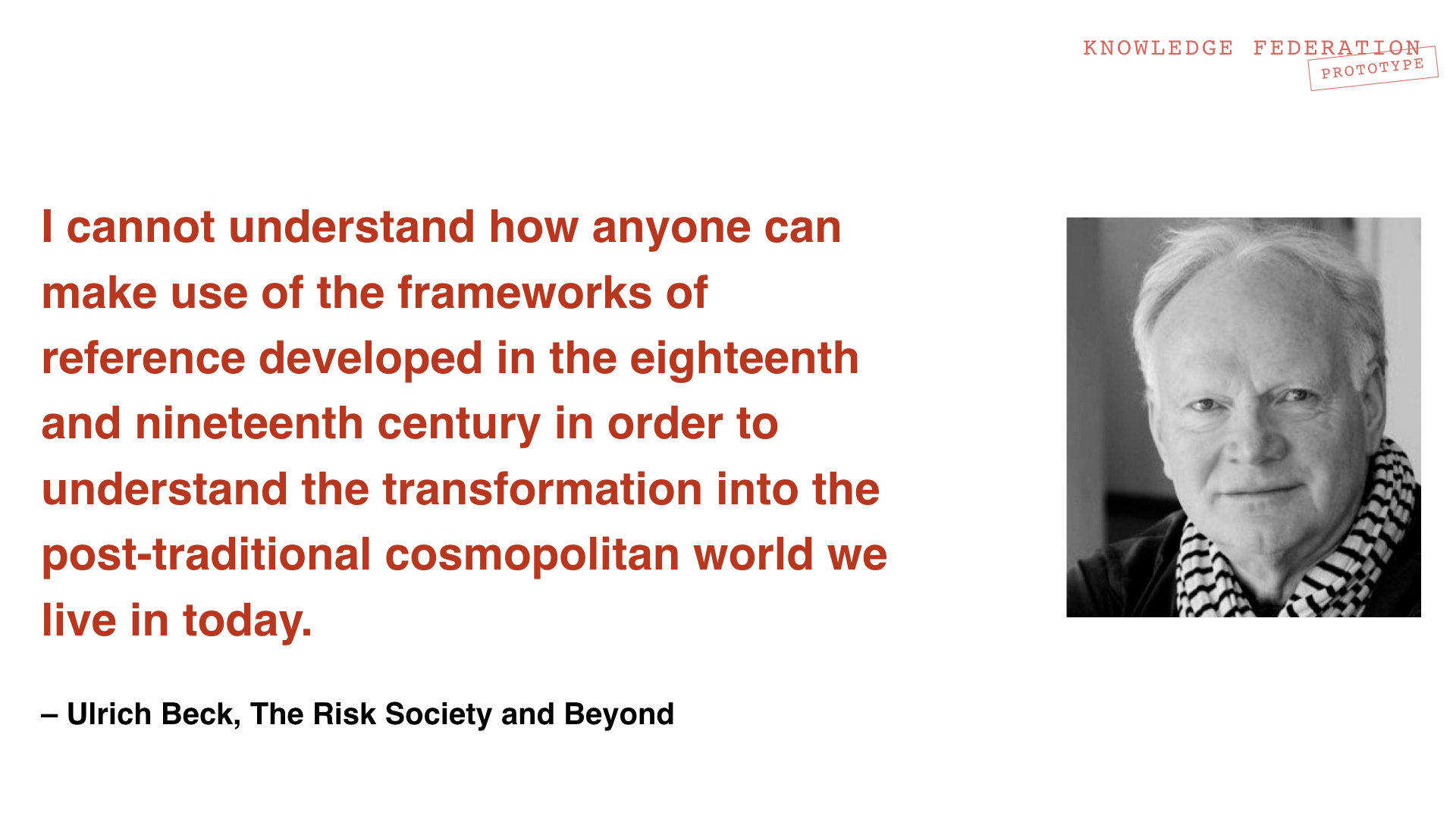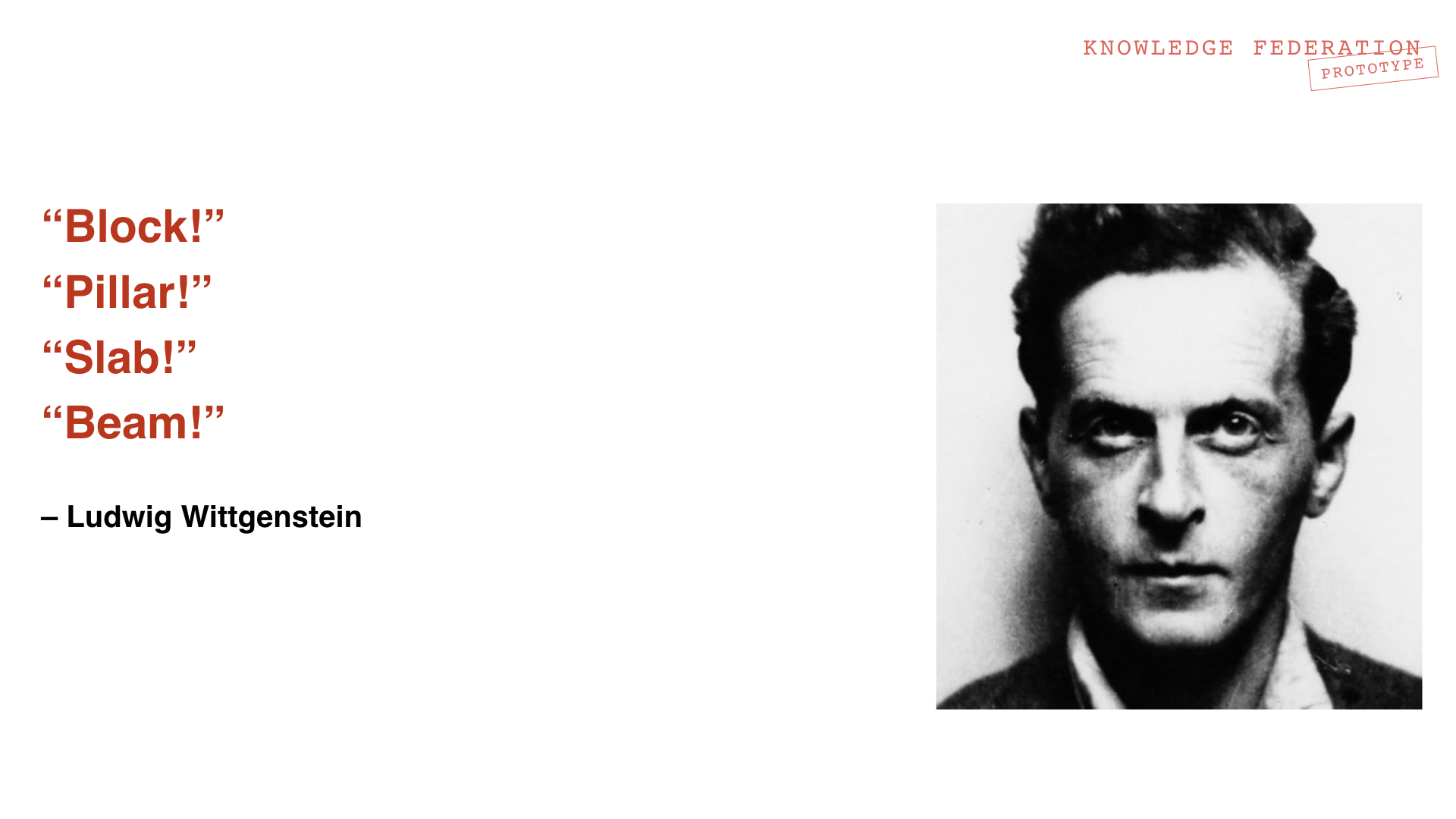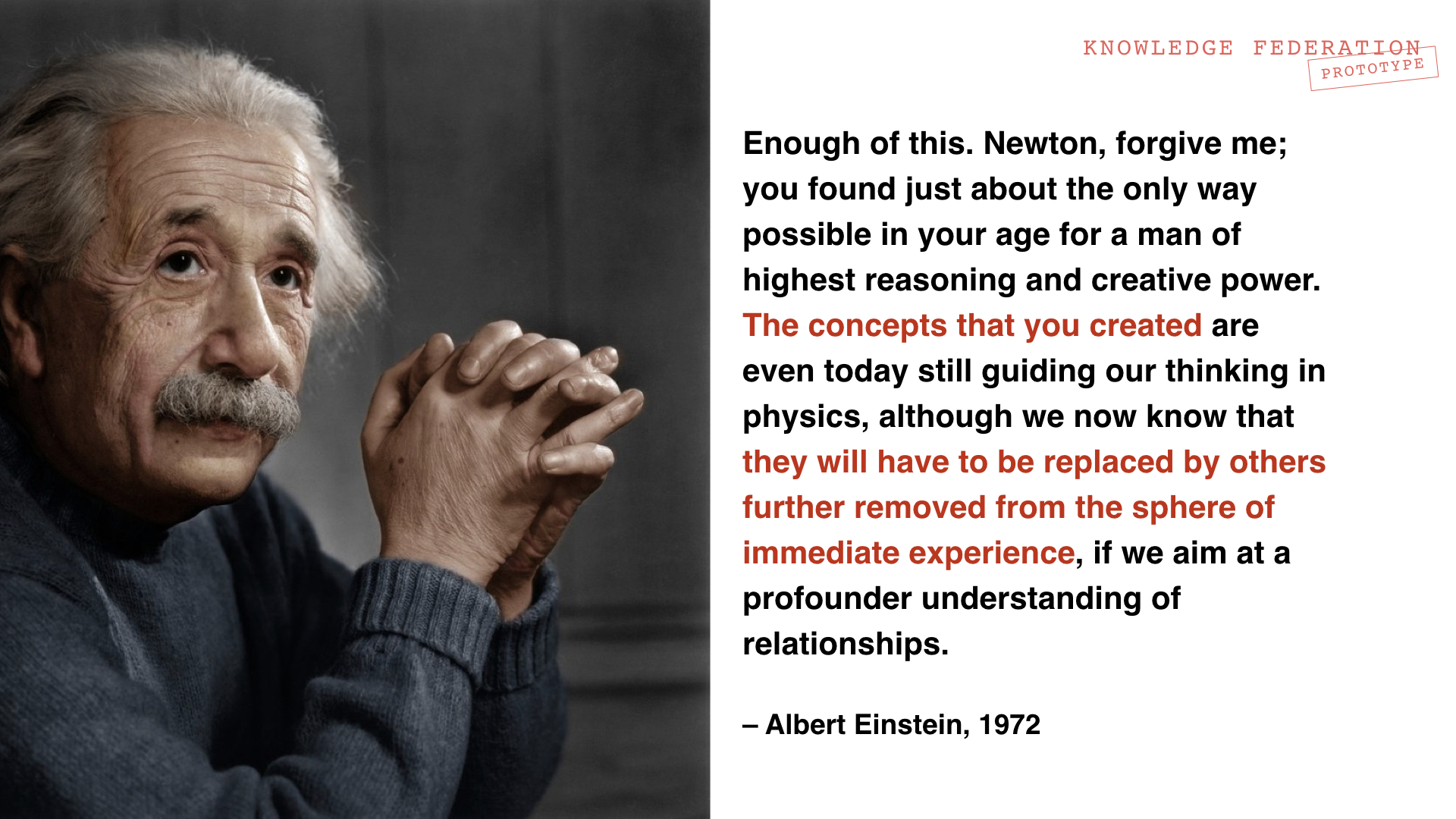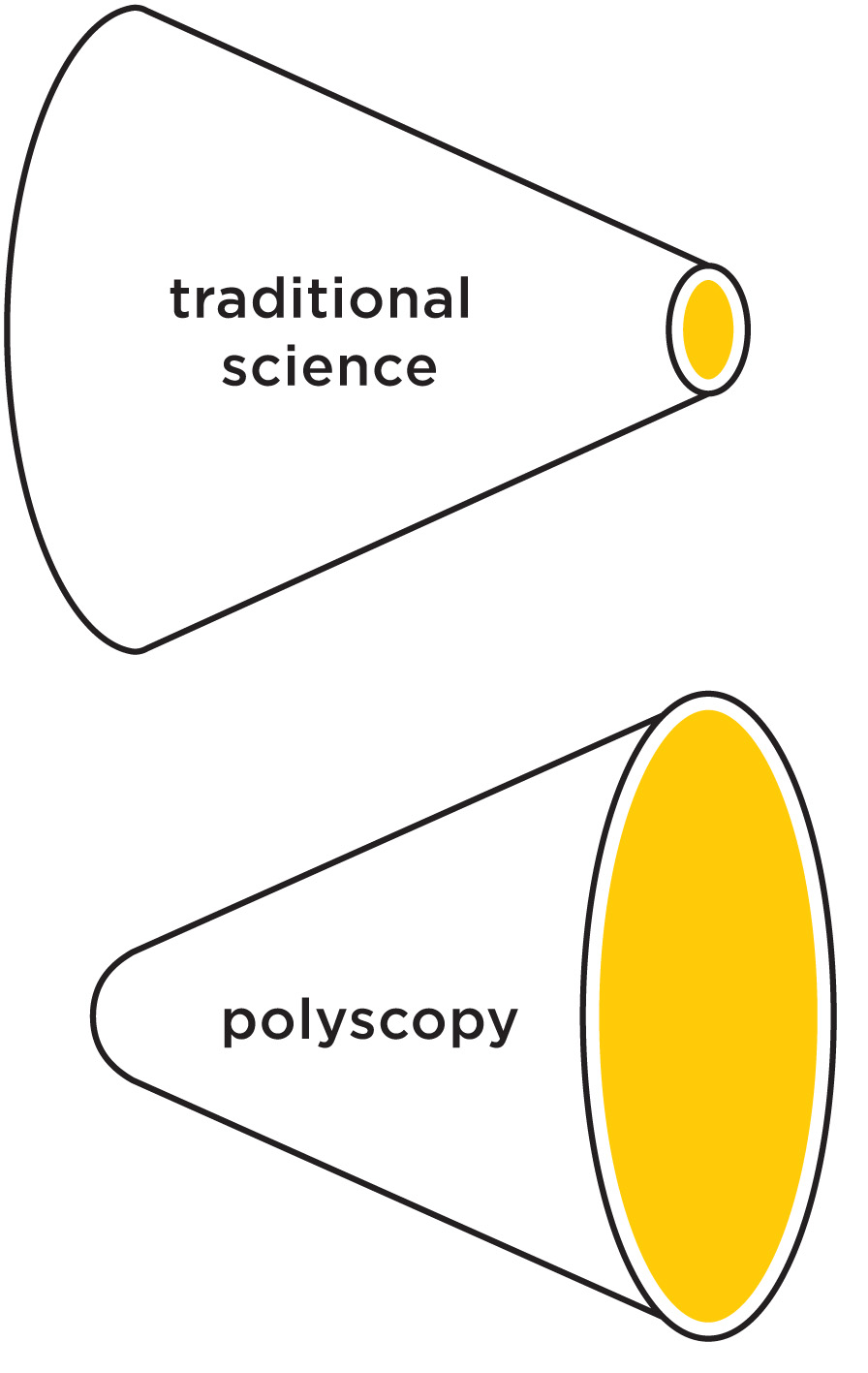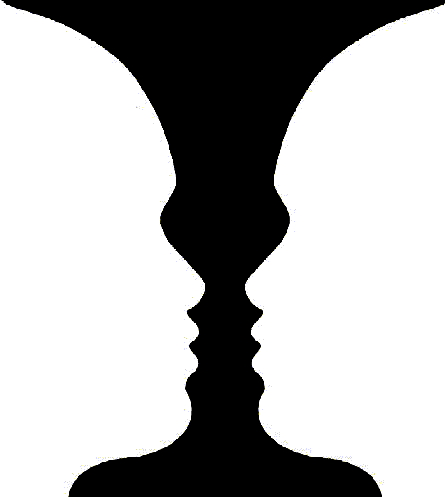Difference between revisions of "Holotopia: Narrow frame"
m |
m |
||
| (20 intermediate revisions by the same user not shown) | |||
| Line 1: | Line 1: | ||
| − | <center><h2><b>H O L O T O P I A: [[ | + | <center><h2><b>H O L O T O P I A: [[Five insights|F I V E I N S I G H T S]]</b></h2></center><br><br> |
<div class="page-header" ><h1>Narrow frame</h1></div> | <div class="page-header" ><h1>Narrow frame</h1></div> | ||
| Line 24: | Line 24: | ||
<blockquote>We have an urgent need for orientation and guidance.</blockquote> | <blockquote>We have an urgent need for orientation and guidance.</blockquote> | ||
<p>In all walks of life—so that we may see things as we need to see them; and direct our efforts productively and wisely.</p> | <p>In all walks of life—so that we may see things as we need to see them; and direct our efforts productively and wisely.</p> | ||
| − | <p>Our point of departure is the fact that nobody really thought about and created the way we create truth and meaning about | + | <p>Our point of departure is the fact that nobody really thought about and created the way we create truth and meaning about the themes that matter. What we have, and use, is a patchwork made out of fragments from the 19th century science (which were there when our trust in tradition failed, and our trust in science prevailed), and popular <em>myths</em>. We tend to take it for granted, for instance, that something is trustworthy, true, legitimate or real, (only) if it is "scientifically proven"—or follows as from scientific "laws", by a causal argument. </p> |
| − | <p>Our point | + | <p>Our point is that <em>we can do better</em>.</p> |
| − | <p>And that our task at hand (em>federating</em> Aurelio Peccei's call to action, to pursue "cultural revival") requires that. </p> | + | <p>And that our task at hand (<em>federating</em> Aurelio Peccei's call to action, to pursue "a great cultural revival") requires that. </p> |
</div> </div> | </div> </div> | ||
| − | |||
| − | |||
| − | |||
| − | |||
| − | |||
| Line 39: | Line 34: | ||
<div class="col-md-3"><h2>We must return to reason</h2></div> | <div class="col-md-3"><h2>We must return to reason</h2></div> | ||
<div class="col-md-7"> | <div class="col-md-7"> | ||
| + | <p> | ||
| + | [[File:Toulmin-insight.jpeg]] | ||
| + | </p> | ||
| + | <p>Stephen Toulmin's book "Return to Reason" provides a <em>historical</em> view of our theme, from the pen of a prominent philosopher of science. Toulmin's point is that <em>for historical reasons,</em> academic research got caught up in a disciplinary pattern deriving from the 19th century physics—which obstructs and confines academic creativity. Toulmin's call to action is to "return to reason"—and apply it creatively and freely (see [https://holoscope.info/2010/02/07/return-to-reason/ our summary]). </p> | ||
| + | </div> </div> | ||
| − | |||
<div class="row"> | <div class="row"> | ||
| Line 46: | Line 45: | ||
<div class="col-md-7"> | <div class="col-md-7"> | ||
| + | <p> | ||
| + | [[File:Heisenberg–frame.jpeg]] | ||
| + | </p> | ||
| + | <p> In "Physics and Philosophy" (subtitled "Revolution in Modern Science"), Werner Heisenberg observed that the way of looking at the world that our general culture adopted from the 19th century physics constituted a "rigid and narrow frame", which was damaging to culture. Heisenberg explained why the results in contemporary physics amounted to a scientific <em>disproof</em> of the <em>narrow frame</em> (see our summary [http://kf.wikiwiki.ifi.uio.no/STORIES#Heisenberg here]). | ||
| + | </p> | ||
| + | <p>Heisenberg foresaw that the epistemological insights reached in modern physics would naturally lead to <em>cultural revival</em>. Click [https://youtu.be/JNSPCUtlXGI here] to hear Heisenberg say that | ||
| + | <blockquote> | ||
| + | Most people believe that the atomic technique is the most important consequence. It was different for me. I believed that the philosophical consequences from atomic physics will make a bigger change than the technical consequences in the long run. (...) So we know because of atomic physics and what was learned from it that general problems look different than before. For example, the relationship between science and religion, and more generally, the way we see the world. | ||
| + | </blockquote> | ||
| + | </p> | ||
| + | </div> </div> | ||
| − | |||
| Line 54: | Line 63: | ||
<div class="col-md-3"><h2>Insights from the humanities</h2></div> | <div class="col-md-3"><h2>Insights from the humanities</h2></div> | ||
<div class="col-md-7"> | <div class="col-md-7"> | ||
| + | <p> | ||
| + | [[File:Beck-frame.jpeg]] | ||
| + | </p> | ||
| + | <p>In the humanities, it is common knowledge that the ways of looking at the world we have inherited from the past will not serve us in this time of change. See our comments that begin [https://holoscope.info/2019/02/07/knowledge-federation-dot-org/#Beck here]. </p> | ||
| + | </div> </div> | ||
| + | |||
| − | |||
| Line 61: | Line 75: | ||
<div class="col-md-3"><h2>Insights from philosophy</h2></div> | <div class="col-md-3"><h2>Insights from philosophy</h2></div> | ||
<div class="col-md-7"> | <div class="col-md-7"> | ||
| + | <p> | ||
| + | [[File:Wittgenstein-insight.jpeg]] | ||
| + | </p> | ||
| + | <p>Wittgenstein observed that words and expressions acquire their meanings only as parts of specific familiar situations, or language-games. His arguments suggest the conclusion that we <em>cannot</em> really use language to "change the game", which is our task at hand (see our comments [https://holoscope.info/2019/02/07/knowledge-federation-dot-org/#Wittgenstein here]; take a look at the reflection that follows, about Robert Oppenheimer's "Uncommon Sense", where it is indicated why not only our language, but also our "common sense" might be a hindrance).</p> | ||
| + | <p>So far we have been repeating what everyone knows—that the way we see the world and make sense of the world is determined by our cultural <em>paradigm</em>. So <em>can we</em> at all liberate ourselves from this entrapment, and communicate in a way that <em>changes</em> the paradigm?</p> | ||
| + | <p>Einstein left us a clue.</p> | ||
</div> </div> | </div> </div> | ||
| + | |||
| + | |||
<div class="row"> | <div class="row"> | ||
<div class="col-md-3"><h2>Insights from Einstein</h2></div> | <div class="col-md-3"><h2>Insights from Einstein</h2></div> | ||
| − | <div class="col-md-7"> | + | <div class="col-md-7"><h3>Knowledge can grow 'upward'</h3> |
| + | <p> | ||
| + | [[File:Einstein-Newton.jpeg]] | ||
| + | </p> | ||
| + | <p>Einstein's "Autobiographical Notes" is, roughly, Einstein's equivalent of Heisenberg's just mentioned book—where Einstein looks back at the whole experience of modern physics, and draws conclusions. Einstein first lists all the successes that were derived directly from Newton's approach, then the "anomalies"—phenomena that could not be handled in that way. Then he offers a somewhat dramatic conclusion, as shown above. </p> | ||
| + | <p> | ||
| + | [[File:Science_on_Crossroads.jpeg]] | ||
| + | <small>Science on a Crossroads <em>ideogram</em></small> | ||
| + | </p> | ||
| + | <p>We condense the whole thing to the above <em>ideogram</em> (an alternative to the one given below?). The moment Einstein was describing was that Newton created a method and a set of concepts, <em>which offered only an approximation</em> of "physical reality"—which was good enough for a couple of centuries of progress, but not any longer. Immediately, Einstein explains that they will have to be replaced (by physicists, of course) by ones "further removed from ...", i.e. ones that are more technical and less intuitive. Science, following its own course, continued to evolve 'downwards'.</p> | ||
| + | <p>But a completely <em>different</em> direction at that point also became possible: To <em>do what Newton did</em> in all walks of life! Create concepts and methods that work <em>approximately</em>, but well enough...</p> | ||
| + | <p>The method we are proposing builds on Einstein's "epistemological credo", given in Autobiographical notes (which we commented on [http://kf.wikiwiki.ifi.uio.no/IMAGES#Einstein-Epistemology here]).</p> | ||
| + | <blockquote> | ||
| + | I shall not hesitate to state here in a few sentences my epistemological credo. I see on the one side the totality of sense experiences and, on the other, the totality of the concepts and propositions that are laid down in books. (…) The system of concepts is a creation of man, together with the rules of syntax, which constitute the structure of the conceptual system. (…) All concepts, even those closest to experience, are from the point of view of logic freely chosen posits, just as is the concept of causality, which was the point of departure for this inquiry in the first place. | ||
| + | </blockquote> | ||
</div> </div> | </div> </div> | ||
| − | |||
| − | |||
<div class="page-header" ><h2>Ideogram</h2></div> | <div class="page-header" ><h2>Ideogram</h2></div> | ||
| + | <div class="row"> | ||
| + | <div class="col-md-3"></div> | ||
| + | <div class="col-md-7"> | ||
| + | <p> | ||
| + | [[File:Polyscopy.jpg]] | ||
| + | <br><small>Polyscopy <em>ideogram</em></small> | ||
| + | </p> | ||
| + | <p>The Polyscopy <em>ideogram</em>, with which we summarize the <em>narrow frame</em> insight, points to its core message: When we understood that the methods developed in the sciences are human-made ways of looking at things or <em>scopes</em> (recall Einstein's "epistemological credo")—it became natural to adapt them to the purposes that need to be served. Such as seeing things whole. </p> | ||
| + | </div> </div> | ||
| Line 81: | Line 124: | ||
<div class="row"> | <div class="row"> | ||
| − | <div class="col-md-3"><h2>Keyword</h2></div> | + | <div class="col-md-3"><h2><em>Keyword</em></h2></div> |
| − | <div class="col-md-7"> | + | <div class="col-md-7"><blockquote><em>Keywords</em> are concepts defined <em>by convention</em>. </blockquote> |
| − | + | <p>By defining concepts <em>by convention</em>, we depart from the <em>narrow frame</em>—as far as the concepts and expressions are concerned. Such definitions remain valid <em>in the context of</em> a given article, or methodology or <em>prototype</em>, and are independent of what the defined words "really mean".</p> | |
| + | <p>This practice is analogous to the usual practice in mathematics and computer programming, to define the main keywords at the beginning. </p> | ||
</div> </div> | </div> </div> | ||
| − | |||
<div class="row"> | <div class="row"> | ||
| − | <div class="col-md-3"><h2> | + | <div class="col-md-3"><h2><em>Pattern</em></h2></div> |
| − | <div class="col-md-7"> | + | <div class="col-md-7"><p>In the generalized approach to knowledge that is based on science, as modeled by the <em>holoscope</em>, the <em>pattern</em> and the <em>ideogram</em> roughly correspond to the mathematical function and the corresponding symbolic representation. "E = mc2" is a familiar example. By why use only mathematics? The <em>patterns</em> and the <em>ideograms</em> generalize the approach to science completely; they can be, in principle, <em>any</em> claim or message.</p> |
| − | + | <p>It is useful here to remind ourselves of Newton's "Mathematical Principles of Natural Philosophy". It marked the beginning of an era—where it was believed, and for perfectly understandable and justifiable reasons, that the nature <em>conforms</em> to mathematical laws <em>of a certain kind</em> (Einstein's exchange with Bohr on the theme whether God plays dice is an interesting aside). The <em>patterns</em> allow us to depart from such assumptions, liberate our language of relationships from them—and <em>still</em> do roughly as Newton did.</p> | |
| + | <p>Many of the <em>keywords</em> we've introduced are defined as <em>patterns</em>. The <em>power structure</em> is an example. Defined in this way, the <em>power structure</em> is not a thing, but a way of looking, and a tendency or deformation that can be present in very many things, which this way of looking reveals. </p> | ||
</div> </div> | </div> </div> | ||
| − | |||
<div class="row"> | <div class="row"> | ||
| − | <div class="col-md-3"><h2> | + | <div class="col-md-3"><h2><em>Ideogram</em></h2></div> |
| − | <div class="col-md-7"> | + | <div class="col-md-7"><p> |
| − | + | <em>Ideograms</em> express <em>patterns</em>. They extend the language from verbal to visual. </p> | |
| + | <p>An early summary of the concept and the applications of the <em>ideogram</em> is presented [https://holoscope.info/2009/11/04/ideograms/ here]. </p> | ||
</div> </div> | </div> </div> | ||
| Line 104: | Line 148: | ||
<div class="row"> | <div class="row"> | ||
| − | <div class="col-md-3"><h2> | + | <div class="col-md-3"><h2><em>Methodology</em></h2></div> |
| − | <div class="col-md-7"> | + | <div class="col-md-7"><p>A <em>methodology</em> is a collection of methods, which includes an explicitly defined (by convention) specification of underlying assumptions (criteria and principles). By specifying or <em>designing</em> a <em>methodology</em>, we depart from the <em>narrow frame</em> also regarding the methods used.</p> |
| − | + | <p>By designing a <em>methodology</em> we become capable of | |
| + | <ul> | ||
| + | <li>designing methods by which we create truth and meaning, and hence departing from the inherited ones</li> | ||
| + | <li>making our methods flexible, or subject to further <em>federation</em></li> | ||
| + | </ul> | ||
| + | </p> | ||
</div> </div> | </div> </div> | ||
<div class="row"> | <div class="row"> | ||
| − | <div class="col-md-3"><h2> | + | <div class="col-md-3"><h2><em>Scope</em> and <em>view</em></h2></div> |
| − | <div class="col-md-7"> | + | <div class="col-md-7"><p>What we have mentioned so far are elements of a <em>scope</em>—which is a way of looking.</p> |
| + | <p>By convention, the meaning is not "out there", it is not objectively existing, and discovered. The meaning is "in the eyes of the beholder". The experience, or "reality", is assumed to be like an ink block in the Rorschach test—something to which we <em>assign</em> meaning. </p> | ||
| + | <p>A <em>view</em> is a specific interpretation of the data, pointed to by a given <em>scope</em>. Communication, and <em>justification</em>, is envisioned as sharing the "aha feeling"—using the given <em>scope</em> and seeing that the proposed <em>view</em> indeed does result from it.</p> | ||
| + | <p>Since the <em>scopes</em> are our own construction and hence precise (exactly as abstract objects in the language of mathematics), we can use them to theorize, and make further abstractions.</p> | ||
| + | </div> </div> | ||
| + | <div class="row"> | ||
| + | <div class="col-md-3"><h2><em>Polyscopy</em></h2></div> | ||
| + | <div class="col-md-7"><p>In the contest of the <em>holoscope</em>, the <em>polyscopy</em> serves the role reserved for "the scientific method" in the conventional <em>paradigm</em>. It is a <em>methodology</em> that enables a free creation of <em>scopes</em> and <em>views</em>—and on all levels of detail or generality.</p> | ||
</div> </div> | </div> </div> | ||
| − | |||
| − | |||
<div class="row"> | <div class="row"> | ||
| − | <div class="col-md-3"><h2> | + | <div class="col-md-3"><h2><em>Gestalt</em></h2></div> |
| − | <div class="col-md- | + | <div class="col-md-6"><p>A <em>gestalt</em> is an interpretation of a situation or issue. To have an "appropriate <em>gestalt</em>" means to have a <em>gestalt</em> that points to action that is appropriate to the situation or issue at hand. "Our house is on fire" is a canonical example.</p> |
| − | + | <p>The keyword <em>gestalt</em> allows us to model what it means to be "informed". To be "informed", one must have an appropriate <em>gestalt</em>. | |
| − | < | ||
| + | <p>In the <em>holoscope</em> order of things, <em>multiple</em>, multiple <em>gestalts</em> are possible (as indicated by the Gestalt <em>ideogram</em> on the right). A challenge the <em>holoscope</em> helps us handle is to find suitable <em>scopes</em>, so that our <em>gestalts</em> may be corrected. </p> </div> | ||
| + | <div class="col-md-3"> | ||
| + | [[File:Gestalt.gif]]<br> | ||
| + | <small>Gestalt <em>ideogram</em></small> | ||
| − | |||
| − | |||
| − | |||
| − | |||
| − | |||
| − | |||
</div> </div> | </div> </div> | ||
| − | |||
| − | |||
| − | |||
| − | |||
| − | |||
| − | |||
| − | |||
| − | |||
<div class="row"> | <div class="row"> | ||
| − | <div class="col-md-3"><h2> | + | <div class="col-md-3"><h2><em>Holoscope</em></h2></div> |
| − | <div class="col-md- | + | <div class="col-md-6"><p> <em>Holoscope</em> is a method that allows us to "see things whole"—and form appropriate <em>gestalts</em>. In the contest of the bus with candle headlights metaphortor, <em>holoscope</em> corresponds to functional 'headlights'. And hence to the final purpose of our quest.</p> |
| − | + | <p>The Holoscope <em>ideogram</em> serves to explain the role the above-described details have in the inner workings of the <em>holoscope</em>. If one should inspect a hand-held cup, to see whether it is cracked or whole, one must be able to look at it from all sides. One must also bring it closer, and inspect a detail, and take it further away to see it as a whole. The control over the <em>scope</em> (and hence an unraveling of the <em>narrow frame</em>, along the lines we have just seen) is what enables the <em>holoscope</em> to fulfill its function.</p> | |
| + | <p>Think about this: In the traditional <em>paradigm</em>, only the things you know "for sure" count as "real knowledge". But here, discovering a way of looking at things that points to something we <em>do not know</em>—but can lead to extreme risks, is actually a sufficient reason to assume that it <em>is</em> "true" (that is, to treat is as such).</p> | ||
| + | </div> | ||
| + | <div class="col-md-3"> | ||
| + | [[File:Holoscope.jpeg]]<br> | ||
</div> </div> | </div> </div> | ||
| − | |||
<div class="row"> | <div class="row"> | ||
| − | <div class="col-md-3" | + | <div class="col-md-3"></div> |
<div class="col-md-7"> | <div class="col-md-7"> | ||
| − | + | <p>A subtle but important point here is that what we've just called 'cracks' might be 'crevices on the road' and 'wrong turns' of our 'bus'—which we as people or as a civilization must be able to avoid.</p> | |
| − | + | <p>This is why in this text and elsewhere we felt it in order to use the conventional language and say, affirmatively, "this is how the things are"—when what we really mean is "this is how the things <em>may be seen</em>, when we look from the given angle". In this way we avoid the cumbersome language—without overstepping too much the way in which this points to the <em>gestalt</em>. A moment of reflection may be needed to see what exactly this means.</p> | |
| − | |||
| − | |||
| − | |||
| − | |||
| − | |||
</div> </div> | </div> </div> | ||
| − | |||
| − | |||
| − | |||
| − | |||
| − | |||
| − | |||
| − | |||
| − | |||
| − | |||
| − | |||
<div class="row"> | <div class="row"> | ||
<div class="col-md-3"><h2><em>Information holon</em></h2></div> | <div class="col-md-3"><h2><em>Information holon</em></h2></div> | ||
| − | <div class="col-md-7"> | + | <div class="col-md-7"><p>Consider the <em>academia</em> as a <em>system</em>. Selected creative people come in, and they are given certain tools to work with, which will decide how socially useful or usable the results of their life work will be. Are the traditional books and articles, which the printing press-related evolution produced, still the best possible option? </p> |
| − | <p>Consider the <em>academia</em> as a <em>system</em> | + | <p> The solution we proposed <em>federates</em> certain core challenges and insights reached in computer programming; and corresponding solution in terms of the Object Oriented Methodology (they are summarized [https://holoscope.info/2019/02/07/knowledge-federation-dot-org/#InformationHolon here].</p> |
| − | |||
| − | |||
| − | <p>The | ||
| − | |||
| − | |||
| − | |||
<p>The <em>information holon</em> is offered as a counterpart to "object" in object oriented methodology.</p> <p>The Information <em>idogram</em>, shown on the right, explains its principle of operation.</p> | <p>The <em>information holon</em> is offered as a counterpart to "object" in object oriented methodology.</p> <p>The Information <em>idogram</em>, shown on the right, explains its principle of operation.</p> | ||
</div> </div> | </div> </div> | ||
| Line 195: | Line 220: | ||
<small>Information <em>ideogram</em></small> | <small>Information <em>ideogram</em></small> | ||
</div> </div> | </div> </div> | ||
| − | + | ||
| + | |||
<div class="row"> | <div class="row"> | ||
<div class="col-md-3"></div> | <div class="col-md-3"></div> | ||
| Line 203: | Line 229: | ||
| − | + | ||
| − | + | <div class="page-header" ><h2>Prototypes</h2></div> | |
| − | <div class="page-header" ><h2> | ||
<div class="row"> | <div class="row"> | ||
| − | <div class="col-md-3"><h2> | + | <div class="col-md-3"><h2>Polyscopic Modeling <em>methodology</em></h2></div> |
| − | <div class="col-md-7"> | + | <div class="col-md-7"><p>Polyscopic Modeling <em>methodology</em> is a concrete <em>prototype</em> of the <em>holoscope</em>. In applications we refer to it by the simpler keyword <em>polyscopy</em>. </p> |
| − | |||
| − | |||
| − | < | ||
| − | |||
| − | |||
| − | |||
| − | |||
| − | |||
| − | |||
| − | |||
| − | |||
| − | |||
| − | |||
| − | |||
| − | |||
| − | |||
| − | |||
| − | |||
| − | |||
| − | |||
| − | |||
| − | |||
| − | |||
| − | |||
| − | |||
| − | |||
| − | |||
| − | |||
| − | |||
| − | |||
</div> </div> | </div> </div> | ||
| − | |||
| − | |||
| − | |||
| − | |||
| − | |||
| − | |||
| − | |||
| − | |||
| − | |||
<div class="row"> | <div class="row"> | ||
| − | <div class="col-md-3"></div> | + | <div class="col-md-3"><h2>Information Must Be Designed</h2></div> |
| − | <div class="col-md-7"> | + | <div class="col-md-7"><p>This book is both a description of <em>polyscopy</em>, and its application—to produce a new <em>kind of</em> book; and a new <em>kind of</em> result.</p> |
| − | <p> | + | <p>The book is structured as <em>information holon</em></p> |
| − | + | <p>The result is a <em>justification</em> of the claim presented in the title—and by the Modernity <em>ideogram</em>; namely that we cannot simply <em>inherit</em> the ways we handle information; we must <em>design</em> a way that truly works (the book's introduction is made available [http://folk.uio.no/dino/IDBook/Introduction.pdf here]).</p> | |
| − | < | ||
| − | </p> | ||
| − | <p>The | ||
| − | |||
| − | |||
| − | |||
| − | |||
| − | |||
| − | |||
| − | |||
| − | |||
| − | |||
| − | |||
| − | |||
| − | |||
| − | |||
| − | |||
| − | |||
| − | |||
| − | |||
| − | |||
| − | |||
| − | |||
| − | |||
| − | |||
| − | |||
| − | |||
| − | |||
| − | |||
| − | |||
| − | |||
| − | |||
| − | |||
| − | |||
| − | |||
| − | |||
| − | |||
| − | |||
| − | |||
| − | |||
| − | |||
| − | |||
| − | |||
| − | |||
| − | |||
| − | |||
| − | |||
| − | |||
| − | |||
| − | |||
| − | |||
| − | |||
| − | |||
| − | |||
| − | |||
| − | |||
| − | |||
| − | |||
| − | |||
| − | |||
| − | |||
</div> </div> | </div> </div> | ||
Latest revision as of 19:42, 17 November 2020
Contents
- 1 H O L O T O P I A: F I V E I N S I G H T S
- 2 Narrow frame
- 2.1 Stories
- 2.2 We must return to reason
- 2.3 Insights from physics
- 2.4 Insights from the humanities
- 2.5 Insights from philosophy
- 2.6 Insights from Einstein
- 2.7 Ideogram
- 2.8 Keywords
- 2.9 Keyword
- 2.10 Pattern
- 2.11 Ideogram
- 2.12 Methodology
- 2.13 Scope and view
- 2.14 Polyscopy
- 2.15 Gestalt
- 2.16 Holoscope
- 2.17 Information holon
- 2.18 Prototypes
- 2.19 Polyscopic Modeling methodology
- 2.20 Information Must Be Designed
H O L O T O P I A: F I V E I N S I G H T S
Narrow frame
Science gave us a completely new way to look at the world. It gave us powers that the people in Galilei's time couldn't dream of. What might be the theme of the next revolution of this kind?
Science was developed as a way to find causal explanations of natural phenomena. Consequently, it has served us well for some purposes (such as developing science and technology) and poorly for others (such as developing culture).
But its main disadvantage in the role of 'headlights' is that it constitutes a 'hammer'; it coerces the creative elite to look for the 'nail'—and ignore the needs of the people and the society.
Stories
This is not an argument against science.
Science has served us excellently in the role it was created for. There is no reason to believe that it will not continue to do so.
Our theme here is how we create truth (what we collectively believe in) and meaning, about the matters of which our daily life and interests are composed. And also those other matters, which demand our attention but remain ignored.
We have an urgent need for orientation and guidance.
In all walks of life—so that we may see things as we need to see them; and direct our efforts productively and wisely.
Our point of departure is the fact that nobody really thought about and created the way we create truth and meaning about the themes that matter. What we have, and use, is a patchwork made out of fragments from the 19th century science (which were there when our trust in tradition failed, and our trust in science prevailed), and popular myths. We tend to take it for granted, for instance, that something is trustworthy, true, legitimate or real, (only) if it is "scientifically proven"—or follows as from scientific "laws", by a causal argument.
Our point is that we can do better.
And that our task at hand (federating Aurelio Peccei's call to action, to pursue "a great cultural revival") requires that.
We must return to reason
Stephen Toulmin's book "Return to Reason" provides a historical view of our theme, from the pen of a prominent philosopher of science. Toulmin's point is that for historical reasons, academic research got caught up in a disciplinary pattern deriving from the 19th century physics—which obstructs and confines academic creativity. Toulmin's call to action is to "return to reason"—and apply it creatively and freely (see our summary).
Insights from physics
In "Physics and Philosophy" (subtitled "Revolution in Modern Science"), Werner Heisenberg observed that the way of looking at the world that our general culture adopted from the 19th century physics constituted a "rigid and narrow frame", which was damaging to culture. Heisenberg explained why the results in contemporary physics amounted to a scientific disproof of the narrow frame (see our summary here).
Heisenberg foresaw that the epistemological insights reached in modern physics would naturally lead to cultural revival. Click here to hear Heisenberg say that
Most people believe that the atomic technique is the most important consequence. It was different for me. I believed that the philosophical consequences from atomic physics will make a bigger change than the technical consequences in the long run. (...) So we know because of atomic physics and what was learned from it that general problems look different than before. For example, the relationship between science and religion, and more generally, the way we see the world.
Insights from the humanities
In the humanities, it is common knowledge that the ways of looking at the world we have inherited from the past will not serve us in this time of change. See our comments that begin here.
Insights from philosophy
Wittgenstein observed that words and expressions acquire their meanings only as parts of specific familiar situations, or language-games. His arguments suggest the conclusion that we cannot really use language to "change the game", which is our task at hand (see our comments here; take a look at the reflection that follows, about Robert Oppenheimer's "Uncommon Sense", where it is indicated why not only our language, but also our "common sense" might be a hindrance).
So far we have been repeating what everyone knows—that the way we see the world and make sense of the world is determined by our cultural paradigm. So can we at all liberate ourselves from this entrapment, and communicate in a way that changes the paradigm?
Einstein left us a clue.
Insights from Einstein
Knowledge can grow 'upward'
Einstein's "Autobiographical Notes" is, roughly, Einstein's equivalent of Heisenberg's just mentioned book—where Einstein looks back at the whole experience of modern physics, and draws conclusions. Einstein first lists all the successes that were derived directly from Newton's approach, then the "anomalies"—phenomena that could not be handled in that way. Then he offers a somewhat dramatic conclusion, as shown above.
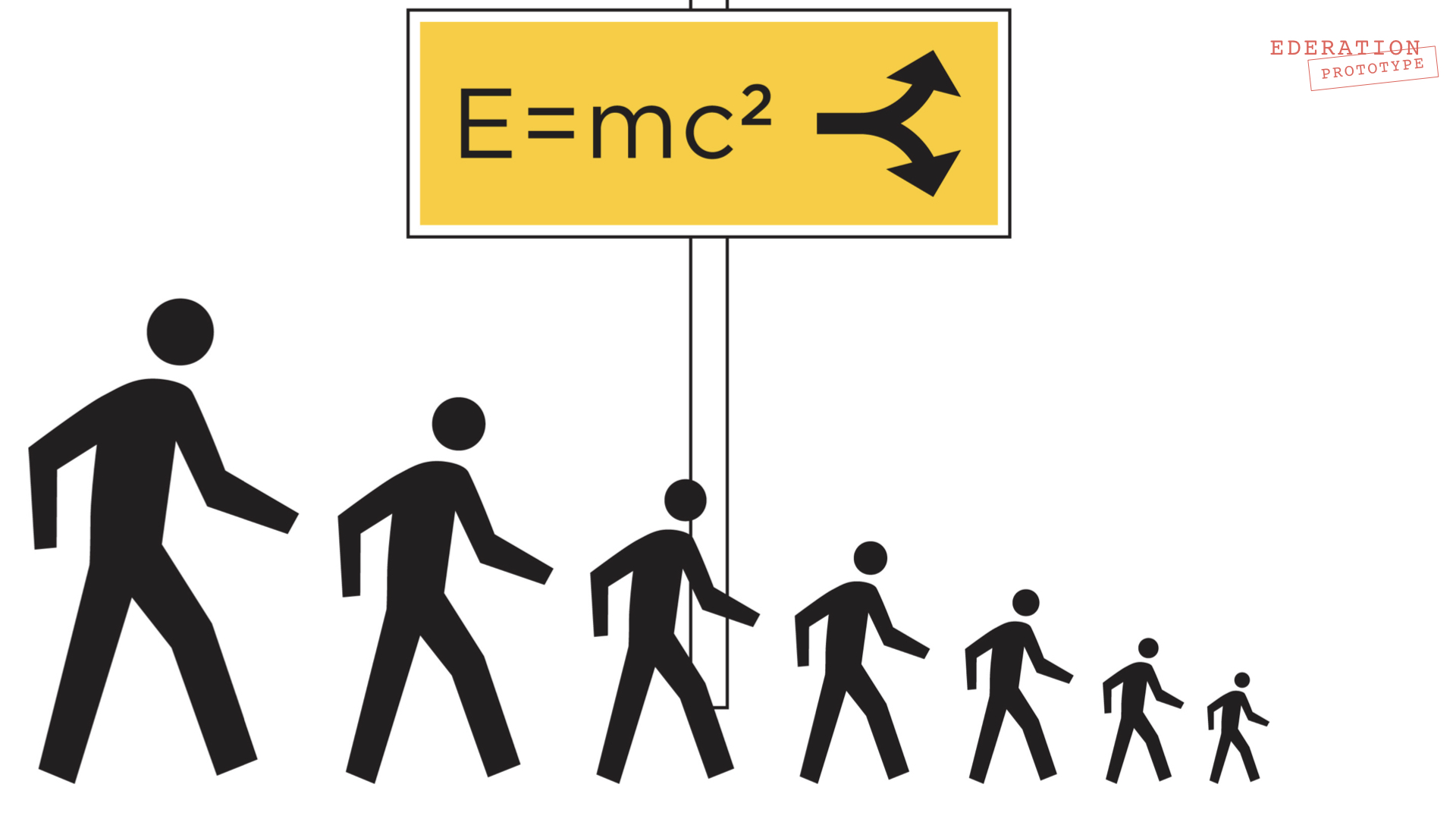 Science on a Crossroads ideogram
Science on a Crossroads ideogram
We condense the whole thing to the above ideogram (an alternative to the one given below?). The moment Einstein was describing was that Newton created a method and a set of concepts, which offered only an approximation of "physical reality"—which was good enough for a couple of centuries of progress, but not any longer. Immediately, Einstein explains that they will have to be replaced (by physicists, of course) by ones "further removed from ...", i.e. ones that are more technical and less intuitive. Science, following its own course, continued to evolve 'downwards'.
But a completely different direction at that point also became possible: To do what Newton did in all walks of life! Create concepts and methods that work approximately, but well enough...
The method we are proposing builds on Einstein's "epistemological credo", given in Autobiographical notes (which we commented on here).
I shall not hesitate to state here in a few sentences my epistemological credo. I see on the one side the totality of sense experiences and, on the other, the totality of the concepts and propositions that are laid down in books. (…) The system of concepts is a creation of man, together with the rules of syntax, which constitute the structure of the conceptual system. (…) All concepts, even those closest to experience, are from the point of view of logic freely chosen posits, just as is the concept of causality, which was the point of departure for this inquiry in the first place.
Ideogram
The Polyscopy ideogram, with which we summarize the narrow frame insight, points to its core message: When we understood that the methods developed in the sciences are human-made ways of looking at things or scopes (recall Einstein's "epistemological credo")—it became natural to adapt them to the purposes that need to be served. Such as seeing things whole.
Keywords
Keyword
Keywords are concepts defined by convention.
By defining concepts by convention, we depart from the narrow frame—as far as the concepts and expressions are concerned. Such definitions remain valid in the context of a given article, or methodology or prototype, and are independent of what the defined words "really mean".
This practice is analogous to the usual practice in mathematics and computer programming, to define the main keywords at the beginning.
Pattern
In the generalized approach to knowledge that is based on science, as modeled by the holoscope, the pattern and the ideogram roughly correspond to the mathematical function and the corresponding symbolic representation. "E = mc2" is a familiar example. By why use only mathematics? The patterns and the ideograms generalize the approach to science completely; they can be, in principle, any claim or message.
It is useful here to remind ourselves of Newton's "Mathematical Principles of Natural Philosophy". It marked the beginning of an era—where it was believed, and for perfectly understandable and justifiable reasons, that the nature conforms to mathematical laws of a certain kind (Einstein's exchange with Bohr on the theme whether God plays dice is an interesting aside). The patterns allow us to depart from such assumptions, liberate our language of relationships from them—and still do roughly as Newton did.
Many of the keywords we've introduced are defined as patterns. The power structure is an example. Defined in this way, the power structure is not a thing, but a way of looking, and a tendency or deformation that can be present in very many things, which this way of looking reveals.
Ideogram
Ideograms express patterns. They extend the language from verbal to visual.
An early summary of the concept and the applications of the ideogram is presented here.
Methodology
A methodology is a collection of methods, which includes an explicitly defined (by convention) specification of underlying assumptions (criteria and principles). By specifying or designing a methodology, we depart from the narrow frame also regarding the methods used.
By designing a methodology we become capable of
- designing methods by which we create truth and meaning, and hence departing from the inherited ones
- making our methods flexible, or subject to further federation
Scope and view
What we have mentioned so far are elements of a scope—which is a way of looking.
By convention, the meaning is not "out there", it is not objectively existing, and discovered. The meaning is "in the eyes of the beholder". The experience, or "reality", is assumed to be like an ink block in the Rorschach test—something to which we assign meaning.
A view is a specific interpretation of the data, pointed to by a given scope. Communication, and justification, is envisioned as sharing the "aha feeling"—using the given scope and seeing that the proposed view indeed does result from it.
Since the scopes are our own construction and hence precise (exactly as abstract objects in the language of mathematics), we can use them to theorize, and make further abstractions.
Polyscopy
In the contest of the holoscope, the polyscopy serves the role reserved for "the scientific method" in the conventional paradigm. It is a methodology that enables a free creation of scopes and views—and on all levels of detail or generality.
Gestalt
A gestalt is an interpretation of a situation or issue. To have an "appropriate gestalt" means to have a gestalt that points to action that is appropriate to the situation or issue at hand. "Our house is on fire" is a canonical example.
The keyword gestalt allows us to model what it means to be "informed". To be "informed", one must have an appropriate gestalt. <p>In the holoscope order of things, multiple, multiple gestalts are possible (as indicated by the Gestalt ideogram on the right). A challenge the holoscope helps us handle is to find suitable scopes, so that our gestalts may be corrected.
Holoscope
Holoscope is a method that allows us to "see things whole"—and form appropriate gestalts. In the contest of the bus with candle headlights metaphortor, holoscope corresponds to functional 'headlights'. And hence to the final purpose of our quest.
The Holoscope ideogram serves to explain the role the above-described details have in the inner workings of the holoscope. If one should inspect a hand-held cup, to see whether it is cracked or whole, one must be able to look at it from all sides. One must also bring it closer, and inspect a detail, and take it further away to see it as a whole. The control over the scope (and hence an unraveling of the narrow frame, along the lines we have just seen) is what enables the holoscope to fulfill its function.
Think about this: In the traditional paradigm, only the things you know "for sure" count as "real knowledge". But here, discovering a way of looking at things that points to something we do not know—but can lead to extreme risks, is actually a sufficient reason to assume that it is "true" (that is, to treat is as such).
A subtle but important point here is that what we've just called 'cracks' might be 'crevices on the road' and 'wrong turns' of our 'bus'—which we as people or as a civilization must be able to avoid.
This is why in this text and elsewhere we felt it in order to use the conventional language and say, affirmatively, "this is how the things are"—when what we really mean is "this is how the things may be seen, when we look from the given angle". In this way we avoid the cumbersome language—without overstepping too much the way in which this points to the gestalt. A moment of reflection may be needed to see what exactly this means.
Information holon
Consider the academia as a system. Selected creative people come in, and they are given certain tools to work with, which will decide how socially useful or usable the results of their life work will be. Are the traditional books and articles, which the printing press-related evolution produced, still the best possible option?
The solution we proposed federates certain core challenges and insights reached in computer programming; and corresponding solution in terms of the Object Oriented Methodology (they are summarized here.
The information holon is offered as a counterpart to "object" in object oriented methodology.
The Information idogram, shown on the right, explains its principle of operation.
The ideogram shows an "i", which stands for "information", as composed of a circle placed on top of a square. The square stands for the details; and also for looking at a theme of choice from all sides, by using diverse kinds of sources and resources. The circle, or the dot on the "i", stands for the function or the point of it all. That might be an insight into the nature of a situation; or a rule of thumb, pointing to a general way to handle situations of a specific kind; or a project, which implements such handling.
By showing the circle as founded on the square, the Information ideogram points to knowledge federation as a social process (the 'principle of operation' of the socio-technical 'lightbulb'), by which the insights, principles, strategic handling and whatever else may help us understand and take care of our increasingly complex world are kept consistent with each other, and with the information we own.
Prototypes
Polyscopic Modeling methodology
Polyscopic Modeling methodology is a concrete prototype of the holoscope. In applications we refer to it by the simpler keyword polyscopy.
Information Must Be Designed
This book is both a description of polyscopy, and its application—to produce a new kind of book; and a new kind of result.
The book is structured as information holon
The result is a justification of the claim presented in the title—and by the Modernity ideogram; namely that we cannot simply inherit the ways we handle information; we must design a way that truly works (the book's introduction is made available here).

